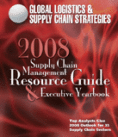
Visit Our Sponsors |
|
|
|
|
|
|
|
|
|
|
|
|
|
|
|
|
|
|
|
|
|
|
|
|
|
|
|
|
|
|
|
|
|
|
|
|
|
|
|
|
|
|
|
|
|
|
|
|
|
|
|
|
|
|
|
|
|
|
|

Analyst Insight
Orchestrating a value network becomes more complex in today's world of globalization, outsourcing, shrinking product lifecycles, and channel consolidation. Traditional, operationally focused and regionalized sales and operations planning processes fall short of the strategic need. Leaders are extending the reach, sophistication and flexibility of standard S&OP into a global and strategic integrated business planning process. Recent research shows a direct path to business results.
-Jane Barrett, research director at AMR Research
Through our research, we find S&OP leaders drive shareholder value through a focus on process excellence and continuous improvement on a global scale, without following any off-the-shelf methodology. Leaders continue to use S&OP to enable coordination across the global value network, but also to drive more explicit, faster, functional alignment with annual operating plans and daily execution. We see 10 basic business principles applied to unlock the value of S&OP (also called integrated business planning or program management):
1. Scope shift-Broader integration of S&OP processes for better insight to global trade-offs, including product launch and phase-out. Ongoing decision-making supported by exception-based pre-S&OP processes.
2. Culture of the ugly truth-Expose the brutal facts and drive a risk orientation. Recognize the limits of lean, pull and the one-number plan. Create a safe harbor for unvarnished business trade-offs.
3. Integrated metrics architecture- Insist on a direct correlation between S&OP decisions and business outcomes. Systematize global accounting. Build a true-costing foundation.
4. A premium on strategic analytical talent-Cultivate C-level finance. Pay premium for the forecasting and planning "right stuff". Invest in people with sophisticated analytical skills.
5. From 180- to 360-degree decision process-Institute multi-enterprise S&OP across the global value network, including partners. Formalize product management touch points. Create concentric, "nested" strategic, tactical planning processes at the operational level.
6. Value segmentation-Where multiple value chains exist, use different S&OP trade-offs and financial drivers. Adjust for industry and regional variations.
7. Scenario architecture-Build a formal integrated "what-if" loop, utilizing the right technology and math and one version of the truth. Support rapid creation and review of alternate S&OP recommendations, with ability to close the loop with planning and execution systems of record.
8. Information infrastructure-Build 360-degree plumbing leveraging software-as-a-service (SaaS) hubs across the extended enterprise and "process playbooks" to link strategy to tactics.
9. Master data management-Tackle data integration with a commitment to global architecture and processes for data cleansing, harmonization and analysis.
10. Explicit road map to value-Executive commitment is critical to compete on insight-to-action cycle time. Mature along six broad vectors with the starting point tied to current state.
The Outlook
No process is more fundamental to reliable earnings growth than sales and operations planning. S&OP is not the solution to all supply chain risks, nor is it a replacement for raw product innovation and collective creativity. But as a hub for global coordination of value trade-offs, S&OP done right is proving itself unsurpassed as a source of earnings growth and market advantage.
We find through a recent study a more direct path to business results. Leaders continue to use S&OP to drive "east-west" coordination. But they also use S&OP to drive more explicit, faster "north-south" alignment with annual operating plans and daily execution. To survive in today's global economy, organizations must nurture these capabilities.
RELATED CONTENT
RELATED VIDEOS
Timely, incisive articles delivered directly to your inbox.


